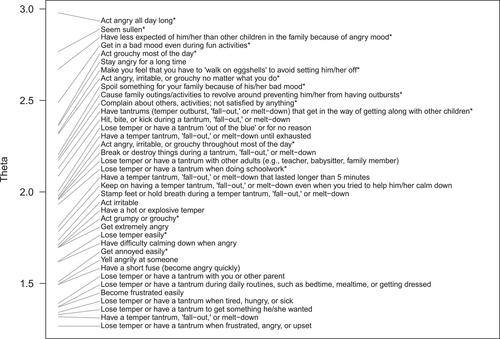Developmentally specified characterization of the irritability spectrum at early school age: Implications for pragmatic mental health screening
Abstract
Objectives
Developmentally specified measures that identify clinically salient irritability are needed for early school-age youth to meaningfully capture this transdiagnostic risk factor for psychopathology. Thus, the current study modeled the normal:abnormal irritability spectrum and generated a clinically optimized screening tool for this population.
Methods
The irritability spectrum was modeled via the youth version of the Multidimensional Assessment Profile Scales—Temper Loss Scale (MAPS-TL-Youth) in children (n = 474; 6.0–8.9 years) using item response theory (IRT). Both cross-cutting core irritability items from the early childhood version and new developmentally specific items were included. Items uniquely associated with impairment were identified and used to derive a brief, clinically optimized irritability screener. Longitudinal data were then utilized to test the predictive utility of this clinically optimized screener in preadolescence (n = 348; 8.0–12.9 years).
Results
Most children exhibit irritability regularly, but daily occurrence was rare. Of the top 10 most severe items from the IRT analyses, 9 were from the developmentally specific items added for the MAPS-TL Youth version. Two items associated with concurrent impairment were identified for the clinically optimized irritability screener (“Become frustrated easily” and “Act irritable”). The MAPS-TL-Youth clinically optimized screener demonstrated good sensitivity (69%) and specificity (84%) in relation to concurrent DSM 5 irritability-related diagnoses. Youth with elevated scores on the screener at early school age (ESA) had more than 7x greater odds of irritability-related psychopathology at pre-adolescence.
Conclusions
The MAPS-TL-Youth characterized the developmental spectrum of irritability at ESA and a clinically optimized screener showed promise at predicting psychopathology risk. Rigorous testing of clinical applications is a critical next step.


 求助内容:
求助内容: 应助结果提醒方式:
应助结果提醒方式:


